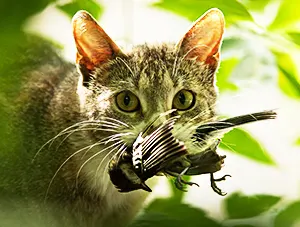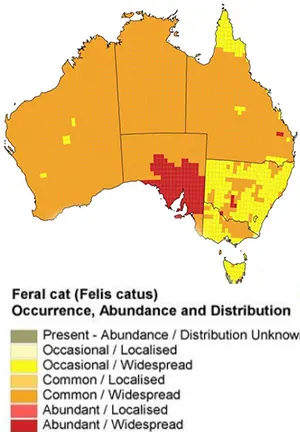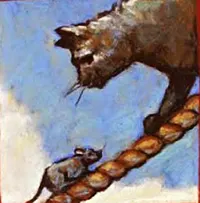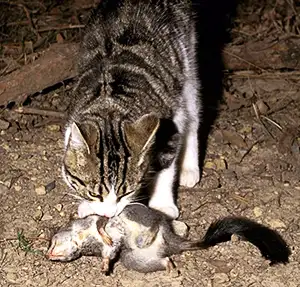Australian Feral Cats: Impact, Facts & Ecology

Contents
What is a Feral Cat?
Feral cats (Felis catus) are domestic cats that have reverted to being wild animals, living and hunting in the wild, independently of humans. They look pretty much like the common everyday household cat. But the key difference is that they are wild animals.
There were no cats or any other native feline species in Australia before European colonization in 1788. Since then, feral cats have spread across nearly every corner of the continent, posing a major threat to native wildlife.
Feral Cat Description
Feral cats are typically:
• Solitary nocturnal, placental mammals that look like the common everyday household cat.
• Lean, muscular, and larger than the average domestic cat.
• 40–60 cm in length and weighing 3–6 kg. The male is larger than the female.
• Mostly short-haired, with common colors including tabby, ginger, grey, and black.
• They are solitary, nocturnal hunters and tend to avoid human interaction.
• Long-haired and white cats are very rare.
Difference Between Feral Cat vs Stray Cat
• Stray cats are homeless domestic pets. They will still interact with humans.
• Feral cats were born in the wild and were never socialised to humans. They will not interact with humans.
• Re-domestication of feral cats is rarely successful.
What do Feral Cats Eat?

Feral cats are carnivorous ambush hunters that use stealth and surprise to pounce and kill their prey.
Feral cats eat:
• Native wildlife such as small marsupials, birds, reptiles, amphibians, insects, and fish. Native Australian wildlife is not used to this sort of aggressive hunting and easily fall prey to these predators.
• Invasive introduced species such as rabbits, rats, mice.
• A feral cat eats about 300 grams of food per day.
Where Do Feral Cats Live?

Feral cats are found throughout Australia except in the wettest rain forests in the north. They adapt easily to various habitats, from urban edges to deserts, and even remote islands.
Feral cats shelter in:
- Hollow logs
- Dense vegetation
- Abandoned burrows
- Human debris
Their home ranges can span up to 10 square kilometres, with males typically ranging farther than females.
Feral Cat Reproduction
From the age of about one year, feral cats can breed in any season. They have up to two litters of about four kittens each year, but few of the young survive.
What Kills Feral Cats
The major predators of feral cats are Dingoes and foxes. Feral cats also fall prey to wedge-tailed eagles.
How Did Cats Get to Australia?

Cats arrived in Australia with the first European settlers on the First Fleet in 1788. It was common practice at that time of all vessels to have their compliment of "ship's cats". They were kept on board to control vermin such as rats, mice and cockroaches on-board ships. Once in Australia, these animals were brought ashore for the same purpose, namely, to keep pests at bay. Besides domestic cats that escaped many cats were also intentionally released around farmland and homesteads to control rats, mice, and rabbits. Many of these animals and their descendants then became feral cats.
There is some speculation that they may have first arrived as the early 17th century on Dutch shipwrecks off the coast of Western Australia, but this has not been substantiated.
How Many Feral Cats Live in Australia?
The actual number of feral cats in Australia is unknown. Estimates vary from 15-20 million to even 23 million feral cats in Australia. A figure of 18 million feral cats is used frequently in technical documentation but there is no credible identifiable source for this number.
Impact of Feral Cats on Native Wildlife

Feral cats are one of the most destructive invasive species in Australia.
Confirmed Impacts of Feral Cats
• Feral cats are ferocious apex predators. Most native animals have not evolved sufficient defence responses against a foreign apex hunter such as the cat and easily fall prey to them.
• Feral Cats are a Serious Threat to Native Fauna. Environmental scientists generally agree that that the feral cat is the most serious threat to smaller native Australian wildlife.
• Threatened Native Animals. Feral cats are thought to threaten the existence of 35 species of birds, 36 mammals, 7 reptiles and 3 amphibians.
• Feral Cats have probably contributed to the extinction. Many small to medium-sized native Australian animals and ground-nesting birds are now extinct due to predation by feral cats.
Controversial or Unverified Claims
• Number of Native Animals Killed. One claim is the feral cats kill 7 million native animals each day. This equates to 27 billion animals killed by feral cats in Australia each year! Another claim puts the number killed at 20 billion a year. (These numbers equate to more than three times the population of humans living on the earth!). There is no credible scientific evidence to support these claims. It is safe to say however, that the number of native animals killed by feral cats is substantial.
Feral Cats Transmit Diseases. There is no clear evidence that these cats are unique in their ability to transmit diseases to other animals.
The Verdict
The general consensus is that feral cats are responsible for the serious depletion of certain types of native Australian fauna. An accurate estimate of the number of feral cats in Australia and their true kill rates are not known.
All Rights Reserved. (Last Updated: May 28, 2025)